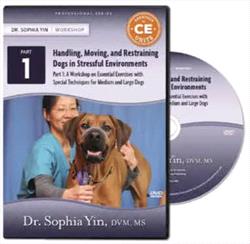Do you ever wonder why seemingly loyal clients suddenly take a hike? Sometimes the issue is money or medical care; however, a surprisingly common reason is that they feel their pet has been mishandled. Just ask Carolyn Martin of Sylva, North Carolina. “I recently switched veterinary practices due to my displeasure at how my dogs were being handled at my previous vet.”
She had been with her one hospital for a while before she realized that the handling was less than ideal. “While I had only small animals, I never noticed how they were (mis) handled,” she states. “I didn’t even question the muzzle put on my elderly small dog who would try to bite them every time they did an examination.” It was when she got an extra-large dog with an orthopedic problem, then a medium-large puppy, that she truly noticed how rough this staff was to her animals.
“They would drag the large dogs by their harness and/or legs onto the scale, and discourage me from assisting or calming them when neither of them wanted to get on. They would not let me hold them or comfort them during an exam. They used the “judo-flop” method to get my dogs on their sides for checks. This all left me fuming, and not long ago I’d had enough (after three episodes of this) and switched vets.”
Luckily she found that some hospitals value good handling skills. She explains, “My new vet is amazing. The elderly dog did not need a muzzle after all, when approached calmly and gently, and given time to see (with very limited vision) and smell the vet, and I was encouraged to lift and hold my dog during the exam. I have not yet been to this vet with my large dogs; however, I have no reason to believe she will not be equally as gentle with them.”
If you think that poor handling only affect client perception about your doggie bed-side manner, think again. “The treatment from my previous vet caused me to doubt their competency, as well as their compassion for the animals in their care,” says Martin. “They seemed to take none but the most aggressive of cues (biting) as to how the dog is feeling. Do they not know the cues? Or do they just ignore them for whatever reason? I also wondered, what would happen to my animals were I not there, if they treat them like this in my presence and feel it is an acceptable method of handling them? Not the kind of care I was comfortable with for my furry family members.”
How to Quickly Gain Needed Handling Skills
How can you pick up the needed handling skills to look credible in the eyes of your clients and to help your patients feel comfortable and safe in your care?
By practicing the exercises in our new low stress handling workshop DVD you can become proficient in just under three hours.
What Will You Learn?
In this workshop DVD consisting of two lab sessions, you’ll learn how to confidently handle large and medium dogs, even dogs who are hyperactive, fearful or reactive. The workshop covers the importance of providing clear direction and guidance to dogs. You’ll participate in exercises on how to properly get dogs from place to place, how to position dogs safely for restraint, how to properly approach and move around fearful or aggressive dogs, how to control movement in all 6 directions, which common neck hold can put you at risk if done improperly, how to control a dog’s head safely and more.
You’ll learn a variety of restraint positions, and the importance of choosing the right technique and adjusting your handling based on the situation, the individual dog, and his responses to you. You’ll also learn the importance of how to get into a particular restraint hold safely and efficiently. In just under 3 hours you’ll have a whole new perspective on handling dogs and a new set of skills.
What’s On the DVD?
Lab 1: (1 hour 38 minutes ): Essential Exercises for Moving Dogs From Place to Place
Major Points:
- Human-only exercises to illustrate how subtle differences in posture, speed and direction of movement dramatically affect the ability to provide clear direction
- The importance of appropriate walking speed and clear movement
- Holding the leash correctly
- U-turns and about-turns
- Stopping with correct body cues
- Maintaining a loose leash
- Speeding up to provide direction
- Positioning dogs correctly with changes of side—front crossover, rear crossover with simultaneous direction change
Lab 2: (1 hour and 9 minutes): Handling and Restraining Medium-sized and Large Dogs with Skill and Ease
Major Points:
- Safely getting into position to restrain a dog
- Controlling movement in all 6 directions
- Minimal restraint for standing dogs
- Three methods for stand to sit
- Three head restraints and the difference in stability
- Minimal restraint with a leash muzzle or Gentle Leader Head collar
- Four different methods of restraint for blood draw—standing for lateral saphenous, sitting for jugular, sitting for cephalic
- Two methods for holding off the cephalic, and one to avoid
- Technique for a smooth standing to lateral transition
All of Dr. Yin’s DVD/online courses are approved by RACE, CCPDT, and IAABC for required CE credits. Learn more, take CE tests, and get your credits here.



